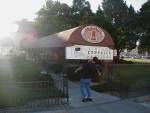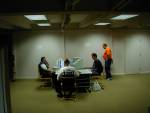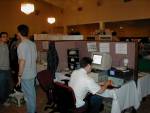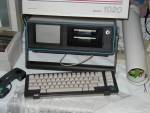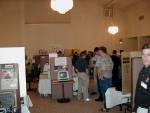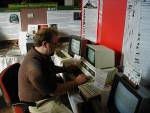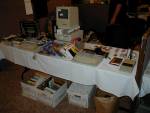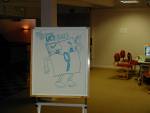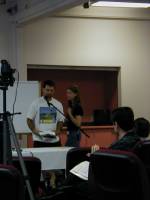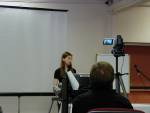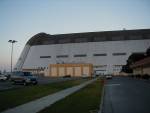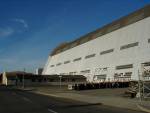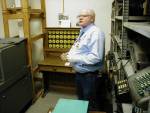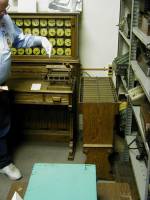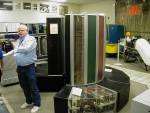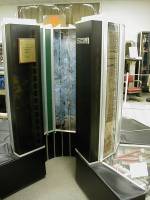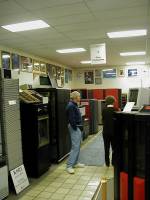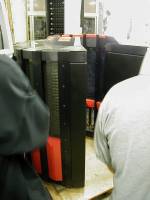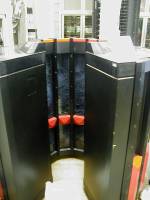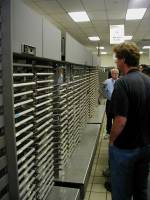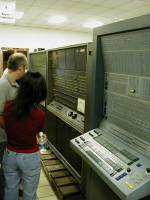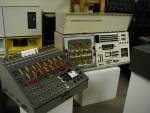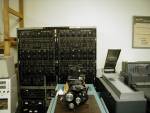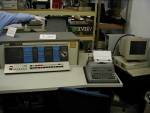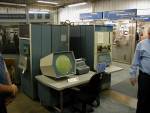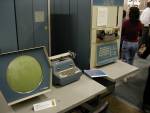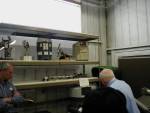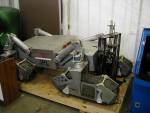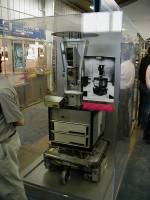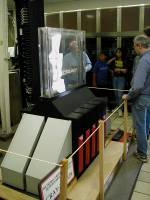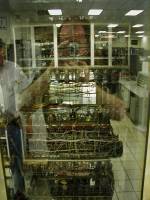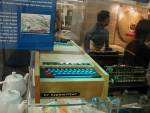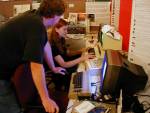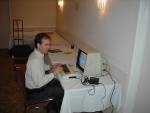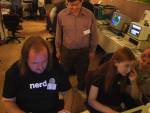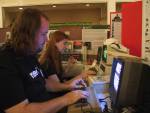Table of Contents
Vintage Computer Festival West 5.0
October 26th & 27th 2002
Moffett Training Center, Sunnyvale, CA updated 11-8-2002
The Vintage Computer Festival is an annual computer show ran by Sellam Ismail, an avid classic computer collector, who saw that enough people would be interested in going to a show about old computers. VCF started in 1997 in California and has since expanded to the East Coast and to Europe thanks to others who share such exuberant interest and with Sellam's help. [link to Vintage Computer Festival's Website]
I have been to all the West Coast VCFs so far; the first being at the Pleasanton Fair Grounds where I was a vendor and saw an opportunity to help with the Commodore computers on display, the second, at the Santa Clara Convention Center Where I had a few Commodore computers on display (including my rare US - P-500'), the third, again in Santa Clara Where I paid a small homage to Atari with an 800 (and participated - and lost - in the Nerd Trivia Challenge), and the fourth was in San Jose along with the arcade collector's show California Extreme 2000 - where I worked on honing my display's look to be more informative. Last year was supposed to be VCF5, but being just a week after the September 2001 terrorist events on the East coast, it was wisely put off for a year.
This year I decided to exhibit three Commodore Machines, the PET (a favorite among attendees), the VIC-20 which I was going to do in 2001 being it was 20th anniversary then and the Commodore 64, celebrating it's 20th anniversary this year (2002). All of which may not be the most unique or rarest of computers, but are usually fondly remembered by those who see them, and with a bit of research I fill in some interesting tidbits that make the display more informative (pics of the various PET versions - at least 8 - and 64 incarnations - 7, including the 128/128D - and some VIC tidbits) Doing three computers can be quite a challenge especially getting enough hardware matching the period (white drive the VIC small IEEE-488 drive for the PET) to make the display look good and also be usable - for a hands-on approach (so that included copying programs to tape and wrangling cartridges and controllers for everything)
As I was working on the expanded display I decided to get a vendor's booth as well - to thin down the excess in my collection (the problem with collecting is you get too much stuff after several years) Unfortunately as my brother and I packed the pickup I could only get the display and stuff to sell from the apartment in so I still have plenty left - next year? -.
It takes about three hours or so to drive from San Andreas to Sunnyvale so to save the exhaustion we went down on Friday, and stayed at a local motel till the next day. Greater San Francisco Bay area traffic can be called exciting as it elevates your blood pressure trying to merge into crowded traffic lanes and commuting at 65+mph on the freeways. Fortunately we were heading in as most folks were heading out. (Getting there a day early was a good idea, relieved a lot of the crankiness from the preparation and trip down) That night I was still working on the display cutting out all the graphics which I printed out the night before.
At the VCF
That morning we were on our way, with only a couple miles of driving the trip to the area was quick, being on part of the Moffett Air Base, we had to show IDs at the guard post to get on the grounds, and then locate the training center (a couple blocks from the huge dirigible hangar)
Setup was about as frantic as packing the day before, sorting out what was for display and to sell as well as finally gluing the graphics to the cardboard panels as well, thanks to the guy next to me (Eric Klien) for being so understanding and lending of cleaner to dust off the monitors whisked directly from the storage shed. Though I missed the pre-exhibit speakers I had everything in place by 2 PM when the exhibit and vendors open to the public. (even before then the sales at my table were good as exhibitors and vendors had an exclusive first opportunity to buy before the public was allowed in - which is also a good incventive to become an exhibitor).
I noticed this year there was an abundance of Sinclair machines (and some Acorns), several Spectrums were for sale and there was an exhibit with a large representation of the Sinclair line (including the 68000 QL with the tiny tape drives) Cameron Kaiser was showing the world how to surf the internet with a Commodore 64, Dale Luck (former Amiga employee)was there with a nice Amiga collection including a rarely seen Amiga in an SX-64 case prototype. Paul Zurakowski, the Mac Man was there with his crowd pleasing Macintosh collection - several early PCs, some DEC PDP 11 computer, Hans Frinke from Germany was there with an internet link to Germany via an ADM31a terminal and with the first production KIM-1. Next to me was an Altair 8080 playing a 'trap the bit' game using its switches and LED display.
Many familiar faces from previous VCFs and also people from the classic computing/ Commodore groups and lists, Robert Bernardo had the Fresno Commodore booth next to mine, and was busy showing off the capabilities of the Commodore computers. Later in the day Jeri Ellsworth arrived and set up her CommodoreOne prototype for all to see, (not much had changed on that unit since I last saw it at AmiWest in July as she was finalizing the PCB layout of the first production model). A few hours into the day I was pleased to meet someone I had known of for years, Brad Templeton, who is famous for such Commodore related things as the PAL assembler, VICTree utility, Time Trek game (for the PET) and later for the news group rec.humor.funny and the Electronic Frontier Foundation. Fortunately, being quick with the camera I coaxed a couple photos of him playing his circa 1979 game of Time Trek on the PET. [photo 1] [photo 2]
Second day - We got there a little early and were able to log onto the internet and I doodled up a VCF welcome message on a flip chart. Once VCF started, things were pretty well running smooth enough I got to wander about a bit more with my wife, Diane, or my brother, Richard, minding the booth.
I made sure to attend Jeri Ellsworth's talk on the CommodoreOne (there's a picture of Sellam introducing Jeri) which was very entertaining as she went a little into her fascination with hardware early on and how she worked into designing the CommodoreOne. On the CommodoreOne, she noted some changes (two Amiga 1200 style clock-ports instead of on-board serial, plug in processor/interface card instead of on-board, and a possible 'ship date'.
.
.
After that I missed the tour on the Air and Space Museum being built in in the dirigible hangar *sigh*, but did catch a tour of the Computer Museum.
The Computer History Museum is the largest computer collection in the United States, their public area are in two rooms, and only shows a tenth of what they have collected (and my photos only show maybe a fourth of that tenth) The tour was about an hour and was a little jumbled in it's presentation as there were three separate tours happening at that time. As with most museums it was a 'look but don't touch' policy, but you did get to see the displays a lot closer then most.
The collection ranges from the earliest, a reproduction of the Hollerith Tabulator card punch reader and sorting unit, which helped IBM create a successful industry (the Hollerith tabulator was first widely used for the 1890 census). to the modern super computers like the Cray 1A, and later Crays.
Here are some of the items that seemed interesting:
Sage Station & Data Bank
A really big control panel
The CDC 6600 - they hired needle workers to do all that wiring!
A few analog machines (no relays here, just voltage levels!)
This IBM 1620 unit is one that actually works, to greatly cut down on the size, the PC to the right simulates all the tape storage and printer units.
The one machine I'd like to see work is this PDP-1, it is capable of running the first video game SpaceWar.
Also included in the museum are several robots, including Stanford's Shaky, some consumer robots, and a JPL moon explorer prototype
This picture shows an ENIAC panel, the JOHNIAC and a cooling pump for a Cray
Here's an unintentional picture of me taking a picture of the JOHNIAC circuitry =-)
Not all the tour was on big computers, it included some pioneering homebrew 70s technology (a TV typer) and personal computers and units from more modern times (a pixar cube)
If you ever plan to be in the area, contact them for an appointment to tour (if you are from outside the US, do this a few weeks ahead of time, because you may be required to apply for a base clearance). Also they are always looking for donations and volunteers. (note, now the Computer history museum is not on Moffet filed, so this is no longer the case.)
After the tour Jeri Ellsworth talked me into doing the 'Programmer Challenge' a mini competition where programmers are given two hours to code a game and be judged on the best. Jeri had planned to be working on her recently acquired COSMAC Elf via a 128 with terminal but the tiny BASIC would not download, so she switched to my PET, I took over the 64 on my exhibit and the third competee was coding on a VIC-20 (which was mine too, as the one he was using had a problem starting up. I was working on a game similar to the PET game Canyon (called Tunnel Flyer), the other gentleman was working on a Snake game, and Jeri was working on an adaptation of a BBS game PimpWars called: Pimp Sim.
I got my game whipped out pretty quick and took a couple snapshots, here is Jeri coding away with the help of my brother, Richard, to get more efficient code (writing a text game in 2 hours is tough, especially on a PET with a semi un-responsive $ key) - my listing is on the monitor in front, and (Garrett?) here, is working on the snake game.
My brother gave me these two pictures to add, one with me on the 64, and Jeri and Courtney (supplying help on the terminology for PimpSim) on the PET with an on-looker, and another one with me and Jeri coding away (side view)
In the end I think the humor of the Pimp Sim won the crowd and Jeri won a black 'nerd' shirt (the 'geek' shirts were all sold out by then). If you want to try the games, here they are: (files not available presently)
Pimp Sim (BASIC for PET, VIC, 64, etc.) by Jeri
Tunnel Flyer (Commodore 64) by Larry
Snake Game (Commodore VIC-20) by the other guy 
After that it was time to pack up and take the three hour+ drive home (Richard had to get up at 4 AM to work, and I at 6, next time we will also take the following Monday off too).
Picked up some stuff that took less space than I sold, I got some Creative Computing Magazines, a few cartridges, and some books, my wife, got an old powerbook. So all in all as with every other VCF, it was well worth the time and effort, so much to do, and so glad I made it there. Hope to see you there next year.

